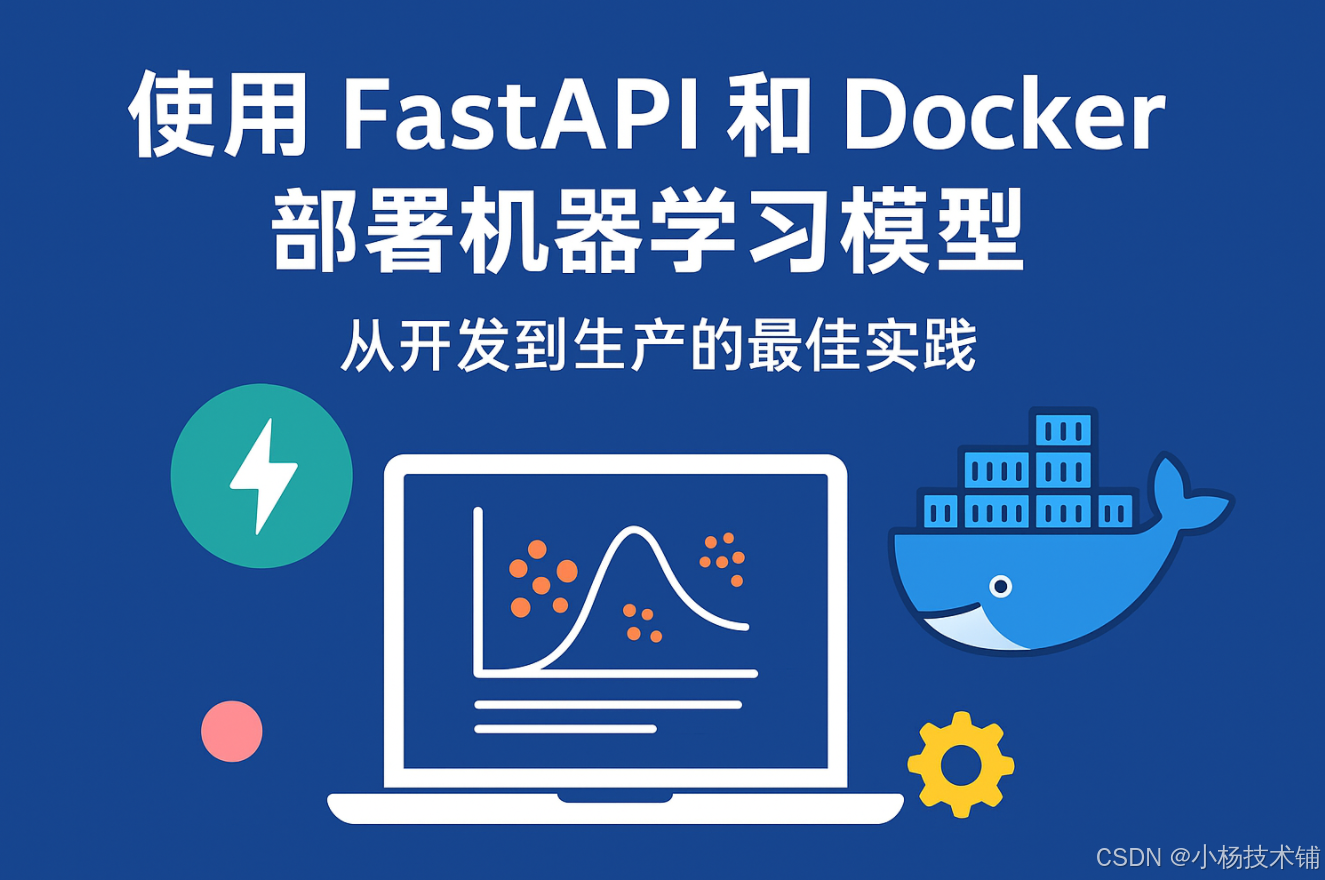使用FastAPI和Docker部署机器学习模型:从开发到生产的最佳实践
前言
在实际的机器学习项目中,模型部署往往是开发流程中最具挑战性的环节之一。不同的环境配置、依赖冲突和系统兼容性问题常常导致"在我机器上能运行"的尴尬局面。本文将详细介绍如何使用FastAPI和Docker构建一个标准化、可扩展的机器学习模型部署方案,让你轻松实现从开发到生产的无缝过渡。
技术栈优势
FastAPI: 高性能Web框架,支持自动API文档生成和类型检查
Docker: 容器化技术,确保环境一致性和可移植性
Scikit-learn: 机器学习库,用于模型训练和预测
Uvicorn: 高效的ASGI服务器,用于运行FastAPI应用
环境准备
在开始之前,请确保系统已安装以下工具:
Python 3.8+
pip (Python包管理器)
Docker
Docker Compose (可选,用于更复杂的部署场景)
项目结构设计
规范的目录结构是项目可维护性的基础,推荐采用如下布局:
iris-fastapi-app/
├── app/
│ ├── __init__.py
│ ├── models/ # 模型相关文件
│ │ └── iris_model.pkl
│ ├── schemas/ # Pydantic模型定义
│ │ └── iris.py
│ └── api/ # 路由处理程序
│ └── endpoints.py
├── core/ # 核心配置
│ └── config.py
├── scripts/ # 辅助脚本
│ └── train_model.py
├── tests/ # 测试文件
│ └── test_api.py
├── main.py # FastAPI应用入口
├── requirements.txt # 项目依赖
├── Dockerfile # Docker构建配置
├── docker-compose.yml # Docker编排配置
└── README.md # 项目说明
模型训练与保存
首先创建模型训练脚本(scripts/train_model.py):
from sklearn.datasets import load_iris
from sklearn.ensemble import RandomForestClassifier
from sklearn.model_selection import train_test_split
from sklearn.metrics import accuracy_score
import joblib
import osdef train_and_save_model():# 创建模型目录os.makedirs('app/models', exist_ok=True)# 加载数据iris = load_iris()X, y = iris.data, iris.target# 划分训练测试集X_train, X_test, y_train, y_test = train_test_split(X, y, test_size=0.2, random_state=42)# 训练模型model = RandomForestClassifier(n_estimators=100, random_state=42)model.fit(X_train, y_train)# 评估模型y_pred = model.predict(X_test)accuracy = accuracy_score(y_test, y_pred)print(f"Model accuracy: {accuracy:.2f}")# 保存模型joblib.dump(model, 'app/models/iris_model.pkl')print("Model trained and saved to app/models/iris_model.pkl")if __name__ == "__main__":train_and_save_model()运行训练脚本:
python scripts/train_model.py
构建FastAPI应用
定义数据模型(app/schemas/iris.py)
from pydantic import BaseModel, Fieldclass IrisInput(BaseModel):sepal_length: float = Field(..., gt=0, description="萼片长度(cm)")sepal_width: float = Field(..., gt=0, description="萼片宽度(cm)")petal_length: float = Field(..., gt=0, description="花瓣长度(cm)")petal_width: float = Field(..., gt=0, description="花瓣宽度(cm)")class Config:schema_extra = {"example": {"sepal_length": 5.1,"sepal_width": 3.5,"petal_length": 1.4,"petal_width": 0.2}}class PredictionResult(BaseModel):prediction: intconfidence: floatclass_name: str创建API端点(app/api/endpoints.py)
from fastapi import APIRouter, HTTPException
import numpy as np
import joblib
import osfrom app.schemas.iris import IrisInput, PredictionResultrouter = APIRouter()# 加载模型
model_path = os.path.join(os.path.dirname(__file__), '../models/iris_model.pkl')
try:model = joblib.load(model_path)
except FileNotFoundError:raise RuntimeError("Model file not found. Please train the model first.")# 类别名称映射
class_names = {0: "setosa", 1: "versicolor", 2: "virginica"}@router.post("/predict", response_model=PredictionResult)
async def predict_iris(data: IrisInput):try:# 准备输入数据input_data = np.array([[data.sepal_length, data.sepal_width, data.petal_length, data.petal_width]])# 进行预测prediction = model.predict(input_data)probabilities = model.predict_proba(input_data)# 获取置信度confidence = float(np.max(probabilities))return PredictionResult(prediction=int(prediction[0]),confidence=confidence,class_name=class_names[int(prediction[0])])except Exception as e:raise HTTPException(status_code=500, detail=str(e))@router.get("/model-info")
async def get_model_info():"""获取模型信息"""return {"model_type": type(model).__name__,"n_features": model.n_features_in_ if hasattr(model, 'n_features_in_') else None,"classes": model.classes_.tolist() if hasattr(model, 'classes_') else None}配置应用(main.py)
from fastapi import FastAPI
from app.api.endpoints import router as api_router
from core.config import settingsapp = FastAPI(title="Iris Classification API",description="一个基于随机森林的鸢尾花分类API",version="1.0.0",docs_url="/docs",redoc_url="/redoc"
)# 包含路由
app.include_router(api_router, prefix="/api/v1")@app.get("/")
async def root():return {"message": "欢迎使用鸢尾花分类API", "docs": "/docs"}@app.get("/health")
async def health_check():return {"status": "healthy"}if __name__ == "__main__":import uvicornuvicorn.run(app, host="0.0.0.0", port=8000)Docker化应用
Dockerfile配置
# 使用官方Python轻量级镜像
FROM python:3.10-slim# 设置工作目录
WORKDIR /app# 设置环境变量
ENV PYTHONDONTWRITEBYTECODE 1
ENV PYTHONUNBUFFERED 1
ENV MODEL_PATH=/app/app/models/iris_model.pkl# 安装系统依赖
RUN apt-get update && apt-get install -y \gcc \&& rm -rf /var/lib/apt/lists/*# 安装Python依赖
COPY requirements.txt .
RUN pip install --no-cache-dir --upgrade pip && \pip install --no-cache-dir -r requirements.txt# 复制应用代码
COPY . .# 创建非root用户
RUN useradd -m -u 1000 appuser && \chown -R appuser:appuser /app
USER appuser# 暴露端口
EXPOSE 8000# 启动命令
CMD ["uvicorn", "main:app", "--host", "0.0.0.0", "--port", "8000"]依赖管理(requirements.txt)
fastapi==0.104.1
uvicorn[standard]==0.24.0
scikit-learn==1.3.2
joblib==1.3.2
numpy==1.24.3
python-multipart==0.0.6
构建Docker镜像
docker build -t iris-fastapi-app .运行容器
# 直接运行 docker run -d -p 8000:8000 --name iris-api iris-fastapi-app# 或使用Docker Compose docker-compose up -d
API测试与验证
使用curl测试
curl -X POST "http://localhost:8000/api/v1/predict" \-H "Content-Type: application/json" \-d '{"sepal_length": 5.1,"sepal_width": 3.5,"petal_length": 1.4,"petal_width": 0.2}'使用Python客户端测试
import requests
import jsonurl = "http://localhost:8000/api/v1/predict"
data = {"sepal_length": 5.1,"sepal_width": 3.5,"petal_length": 1.4,"petal_width": 0.2
}response = requests.post(url, json=data)
print(json.dumps(response.json(), indent=2))生产环境优化建议
1. 性能优化
使用Gunicorn作为进程管理器:
CMD ["gunicorn", "-k", "uvicorn.workers.UvicornWorker", "main:app", "--bind", "0.0.0.0:8000", "--workers", "4"]
添加Nginx反向代理处理静态文件和负载均衡
2. 监控与日志
集成Prometheus指标监控
添加结构化日志记录
设置健康检查端点
3. 安全加固
启用HTTPS
添加API密钥认证
设置速率限制
输入验证和清理
4. 持续集成/部署
使用GitHub Actions自动化测试和部署
添加多阶段Docker构建减少镜像大小
设置容器扫描和安全检查
常见问题排查
模型文件找不到:确保训练脚本已运行且模型路径正确
依赖冲突:使用虚拟环境或Docker确保环境一致性
端口冲突:检查8000端口是否被其他应用占用
内存不足:调整Docker资源限制或优化模型大小
总结
通过本文的介绍,我们学习了如何使用FastAPI和Docker构建一个完整的机器学习模型部署方案。这种方法的优势在于:
环境一致性:Docker确保开发、测试和生产环境的一致性
易于扩展:容器化部署便于水平扩展和负载均衡
标准化API:FastAPI提供自动文档生成和类型检查
维护简便:清晰的项目结构和配置管理降低维护成本
这种部署模式不仅适用于简单的机器学习模型,也可以扩展到复杂的深度学习应用和大规模服务架构。希望本文能为你的机器学习项目部署提供实用的参考和指导。

